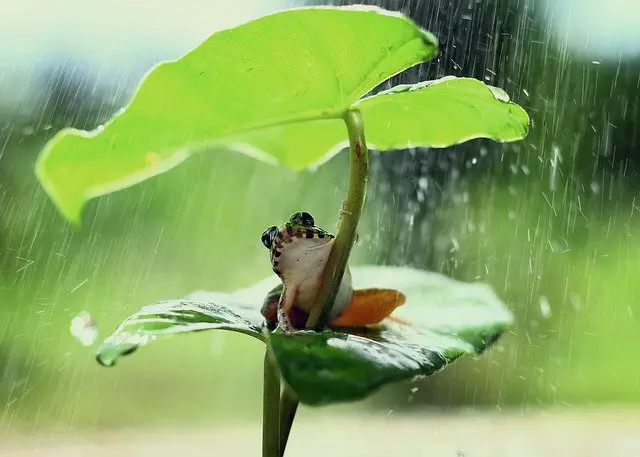Keeping more than one species in a vivarium needs a bit of consideration, especially with amphibians and reptiles. Some species like the Tokay gecko can easily consume your pet frog. A white-lipped tree frog can overpower a gecko as well.
This begs the question, can giant day geckos live with frogs? Since giant day geckos are diurnal while most frogs are nocturnal, they can be compatible.
Nevertheless, their cage needs, such as temperature and surroundings, may also need to be compatible. Luckily, day geckos and frogs have similar vivarium requirements, so they may be able to become cage mates.
Stick around to learn more about how compatible giant day geckos are with frogs and how you can create the ideal environment for these roomies.
Are Giant Day Geckos Compatible with Frogs?
While giant day geckos can be compatible with frogs, this enclosure’s maintenance is by no means going to be simple. It’ll need watchful eyes because a lot may go wrong. This is why we wouldn’t recommend mixing species in your vivarium if you’re a novice owner.
You’ll want to understand the cage requirements needed for building a co-habitat. That’s why it’s best first to get an overview of each of the species individual cage requirements.
Giant Day Gecko Cage Requirements
The tropical giant day gecko is classified as a tropical species. It needs about 55% to 65% humidity and a cage temperature of about 80 to 75 degrees F.
As an arboreal species, they’re fond of climbing, so you may need to consider a vertical vivarium with top and bottom ventilation systems. Now, the size of the vivarium will need to be around 29 to 30 gallons to house a giant day gecko.
The Madagascar species love plants to mimic their natural environment. As climbers, you may need to provide spiraling thick branches and vines where your gecko can crawl around. Giant day geckos also enjoy drinking from droplets cascading from sprayed leaves.
In terms of diet, this gecko species mainly consume various fruits and insects. It can chow down on crickets, locusts, waxworms, mealworms, and mango.
Frog Cage Requirements
Each one has its respective cage requirements with a myriad of frog species. For instance, bullfrogs need about 20 gallons of cage space with a temperature of around 77 to 84 degrees F. Meanwhile, fire-bellied frogs require a smaller 10 to 15 gallons container and a temperature ranging between 75 to 78 degrees F.
Some pets, like the white tree frogs, are arboreal, while others, like horned frogs, are terrestrial, meaning they’re mostly grounded. Depending on each option, climbers would need a vertical enclosure while terrestrial frogs require a horizontal vivarium.
When feeding time rolls around, most frogs need an animal protein-rich diet consisting of insects and worms. Ideally, you can feed them roaches or crickets with sprinkled supplements. Interestingly, some frog species like the South American horned frog can swallow a small rodent every once in a while.
Compatibility of Giant Day Geckos and Frogs
After getting an idea of the environments needed for giant day geckos and frogs, you may have noticed some similarities. While some resemblances are good, others may not be, such as whether or not each animal is arboreal or terrestrial.
In which case, having an arboreal giant day gecko with an arboreal frog may not be the best idea. Instead, you can house a terrestrial frog. That way, they’ll have an unspoken separate environment, where none would bother the other. This is especially true since the gecko is diurnal, while frogs are naturally nocturnal.
What to Consider Before Letting a Giant Day Gecko Live with Frogs
Giant day geckos and frogs may be able to live together, but there are some considerations you should be aware of. For example, the frog species you choose to cohabit with your giant day gecko may need to be terrestrial and non-poisonous. That said, here’s what you’ll want to look out for.
Cage Space and Climate
Since you’ll own two or more animals in the vivarium, you need to ensure adequate space. Giant day geckos and most frog species tend to be territorial, so you’ll want a cage that offers the same space as their vivarium.
In other words, if giant day geckos need a 30-gallon container and a frog needs a 15-gallons space, you’ll want to purchase a 45-gallon vivarium.
Another aspect worth addressing is temperature. Giant day geckos require an 80 to 75 degrees F temperature-regulated cage with lots of humidity. Fortunately, most frog species need the same climate, ranging between 85 to 75 degrees with 60% to 80% humidity.
Behavior
Geckos and frogs are animals, and animals can fight violently. Nevertheless, if both species barely cross paths, you’ll have better chances of achieving a mutual understanding from both ends.
The good news is that you may not run into much trouble with giant day geckos and frogs. It’s basically like having two roommates, one working a day shift and the other a night shift.
Health Inspection
Behavior and environment aside, geckos and frogs can carry diseases detrimental to one another. For this reason, you’ll have to quarantine each animal for at least a few months. We suggest going to the vet for a fecal parasite exam to be safe.
If tests come back positive, you may need to lengthen the quarantine period. This will ensure a safe co-habitual cage for your giant day gecko and frogs.
To Conclude
Can giant day geckos live with frogs? In some cases, they can, but it depends on the frog species you choose to add to the gecko’s vivarium. In addition to this, temperature, behavior, and health concerns need to be addressed beforehand.
Owning a mixed species vivarium can be difficult for first-time pet owners. We’d recommend it to herp keepers that are more knowledgeable about each species’ condition.




